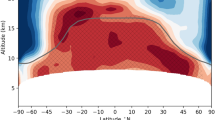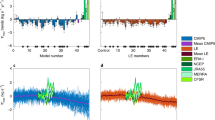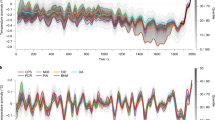Abstract
The success of our method1 for reconstructing tropospheric temperature trends is reinforced by Gillett et al.2, who show that our method is robust for reconstructing the tropospheric temperature trends, and that the statistical relationships between our T4, T2 and T850–300 estimates are in agreement with those independently derived from climate-model output. But Tett and Thorne3 use different data sets in the tropical region and suggest that our approach produces tropospheric temperature trends that are biased to warm and that it overfits the data. We argue that the differences in tropical tropospheric temperature trends between our estimate of T (Tfjws) and the T850–300 of Tett and Thorne do not invalidate our method. We also question their interpretation of the comparison between global climate model results and satellite observations.
Similar content being viewed by others
Fu et al. reply
We first clarify that the quasi-biennial oscillation (QBO) issue that they raise is irrelevant to the trend analyses because the QBO signal is periodic. It is also incorrect that our weightings were negative above 100 hPa in the tropics. In reality, T2 still has a significant weight above 100 hPa (ref. 4) and so should experience QBO effects. By contrast, our weighting function changes sign from positive to negative at about 75 hPa and has much smaller absolute values than the T2 weighting function throughout the tropical stratosphere (see Fig. 3 of ref. 5).
Tett and Thorne show discrepancies between Tfjws and T850–300 trends ranging from −0.02 to 0.06 K per decade for different data sets applied to the tropics, and so claim that our approach is biased to warm. We have shown that our weighting function is largely free of the stratospheric influence (Fig. 3 of ref. 5). However, these large trend differences arise because, in the tropical region, our weighting function is attributed to the whole troposphere from the surface to the tropopause (about 100 hPa), including a significant contribution from the layer between 300 hPa and 100 hPa, where the temperature trends are poorly characterized but might be very different from those below6.
For the tropical region, where the tropospheric temperature trends have significant height dependence, we argue that the Tfjws trend is more representative of the entire troposphere than of the T850–300 layer. For example, for the ERA40 data for 1979–2001 in the tropics, there is a moderate positive temperature trend below 775 hPa, a moderate negative trend between 700 and 400 hPa, and a very strong positive trend between 300 hPa and tropopause. The T850–300 trend excludes the large positive contribution from the upper troposphere, which leads to a much smaller trend for T850–300 than for Tfjws. The large discrepancy with ERA40 data therefore arises owing to its very complex vertical structure of trends, which has not been shown to be realistic. If it is real, it indicates that the T850–300 trend does not represent the layer-mean trend of the entire tropical troposphere but that the Tfjws trend does. The trend comparison, which shows a mean difference of 0.01 K per decade between Tfjws and T1,000–100 (mass-weighted temperatures from 1,000 to 100 hPa) in Table 1, supports our argument.
Tett and Thorne assert3 that the average tropospheric temperature trends from an ensemble of coupled atmospheric–ocean model simulations are similar to those in the atmosphere-only case. However, we notice that the average ratio of Tfjws to surface-temperature trends is about 1.4 from the coupled model, which is different from the atmospheric-only result (about 1.8); the former is consistent with the trend ratio derived from the RSS (Remote Sensing Systems) data (about 1.4) (Table 1). Understanding the differences between the HadAM and HadCM results are outside the scope of our study1, but we notice that the global climate simulation with prescribed sea surface temperature does not conserve energy.
We performed tests, similar to those done by Tett and Thorne3, to check the sensitivity of the regression coefficients to different data sets6 and to the choice of training periods. The scatter in derived coefficients was within 10%, in agreement with their findings. Using the observed Microwave Sounding Unit T2 and T4, this leads to an uncertainty of, at most, 0.01 K per decade in the derived tropospheric temperature trends. Our more recent analysis5, in which we directly apply our effective weighting function1 to observed profiles of stratospheric temperature trend, reveals that our approach does remove the stratospheric influence effectively, leaving a residual influence of less than 0.01 K per decade5. Furthermore, by comparing T2 and Tfjws in Table 1, we notice a robust stratospheric contamination in tropical T2 trend, insofar as it depicts the tropospheric trend: it is about −0.06 K per decade from both satellite Microwave Sounding Unit data sets, radiosonde, and both global climate model outputs (only ERA40 reanalysis shows a smaller stratospheric influence in T2).
This reply was prepared with input from Kevin E. Trenberth.
References
Fu, Q., Johanson, C. M., Warren, S. G. & Seidel, D. J. Nature 429, 55–58 (2004).
Gillett, N. P., Santer, B. D. & Weaver, A. J. Nature doi:10.1038/nature03209 (2004).
Tett, S. & Thorne, P. Nature doi:10.1038/nature03208 (2004).
Christy, J. R., Spencer, R. W. & Lobl, E. S. J. Clim. 11, 2016–2041 (1998).
Fu, Q. & Johanson, C. M. J. Clim. 17, 4636–4640 (2004).
Seidel, D. J. et al. J. Clim. 17, 2225–2240 (2004).
Author information
Authors and Affiliations
Corresponding author
Rights and permissions
About this article
Cite this article
Fu, Q., Seidel, D., Johanson, C. et al. Stratospheric cooling and the troposphere (reply). Nature 432, 2 (2004). https://doi.org/10.1038/nature03210
Published:
Issue Date:
DOI: https://doi.org/10.1038/nature03210
Comments
By submitting a comment you agree to abide by our Terms and Community Guidelines. If you find something abusive or that does not comply with our terms or guidelines please flag it as inappropriate.



